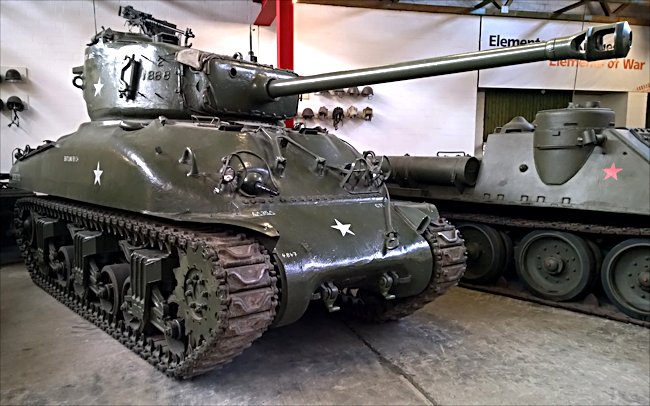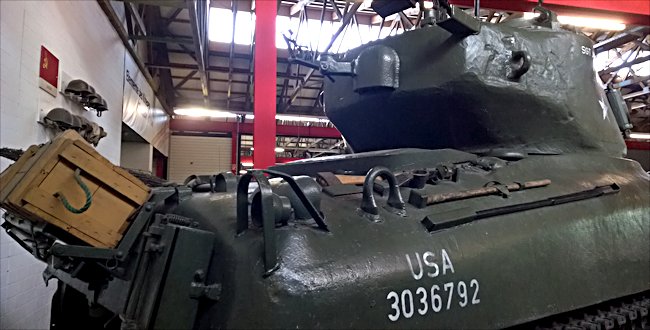M4A1 Sherman 76mm Tank
This M4A1 Sherman Tank has a large 76mm long barreled gun and can be found at the Deutsches Panzermuseum in the small military town of Munster, Germany.

M4A1 Sherman Tank cast hull with a 76mm gun
Sherman tanks battle for Calcar Ridge
The Rhineland is fertile farm land in west Germany. In the winter of 1945 it is the scene of the most ferouscious and costly battles of the Second World War. On the 8th February 1945 Allied armoured units roll across Germany’s western borders. Leading the attack is the 1st Canadian Army’s Sherman tanks. Their objective is to find a crossing over the River Rhine and then into central Germany. They head from their base in Holland towards the bridge of the river at the German town of Xanten (pronounced Zanten).
The Allies have amassed 90,000 troops 1300 artillery pieces and over 1,000 tanks. Most of the Sherman tanks still had the short barrelled 75mm gun rather than the larger US 76mm gun or the larger British 17pdr gun fitted to the Firefly version of the Sheman. They only had 50mm of frontal armour. What they lacked in firepower and protection compared to the German panzers, they made up for in manoeuvrability and numbers of vehicles. They were also quite rugged and did not need a lot of maintenance unlike many of the German tanks that suffered from regular mechanical breakdowns.
German tank crew Sgt. Hans Herbst, 116th Panzer Division remembers, "The Sherman had a short barrelled gun so they could only damage us at very short range, unlike out Panther tank. We had a long barrelled high velocity 75mm cannon on the Panther and could pick them off at a distance knowing they could not fire back and hurt us. The Allies had so much better amount of equipment, fuel, supplies and ammunition. We could not compete with that. By 1945 we barely had enough tanks left.".

The M4A1 is a Sherman Tank that has a cast hull and turret with a 76mm gun
The Panther tank had 80mm of frontal sloping armour which meant that many of the Sherman tank shells would bounce off or if they did start to penetrate the armour, did not have enough power to go all the way through this amount of armour. To defend the Rhineland the German Army only had a handful of panther tanks, less than 12 Tiger I tanks and under 100 anti-tank guns.
It was an enormous disparity in men and firepower, but the German troops still believed they had the cunning, skill and drive to defend their homeland. They were no longer fighting just for Hitler. They were fighting for their own country from invaders. Many German troops became fanatical in the defence of the land they loved and for their families.
Sgt. Hans Herbst commented on this. "For many of the soldiers their homes had been destroyed, family members killed ,in the Allied bombing and they told themselves, what am I supposed to do at home now? I am going to take a few more enemies to their graves before I die. That was what they were thinking and saying."
The Allies found they were now fighting for every little farm house, village, town and forest. The assault slows because of German resistance. In 18 days of fighting the Allis lose over 8,000 men and hundreds of tanks whilst only having achieved an advance of 25km. Canadian Lt-General Guy Simmonds, who had master minded the first ever armoured night attack, during operation Totalize, that had enabled the break out from Caen to close the Falaise Gap was sent in to sort out the problem.
He implements operation Blockbuster, another bold armoured night attack. It would require the high ground between the German villages of Calcar and Udem to be taken, to cover the main force travelling along the valley floor. This main thrust would be aimed at the gap in the Hochwald ridge where the remaining of the German armour was dug in. this was the last line of German defence before the River Rhine and the bridge at the town of Xanten.
The spring melt came early. There was mud everywhere. The Rivers were high and in spate. Some of the lake and reservoir dams were breached by the Germans so as to make some areas of low lying farm land impassable. The maps issued to the Allied tank commanders became useless.
Sgt. Hans Herbst commented, "To the left and right of the raised roads the ground had turned into swamp. The allied tanks had to stay on the roads. They could not use the fields. There they were very easy targets for us. If you hit the rear tank and then the leading tank they were stuck. You could then take your time selecting new targets."
In the early morning of 26th February 1945, Canadian infantry supported by 80 tanks of the 2nd Canadian Armoured Brigade launched phase one of Operation Blockbuster, to take and hold the German held Calcar ridge. Around 700 allied artillery guns target the ridge first. Sherman tank gun loader Trooper John Hale, Sherbrooke Fusiliers remembers, "It was night and raining. The ground was in a very bad condition. The first three tanks hit mines. The Teller mine would blow a Sherman tank’s track off and immobilise it. The floor of the tank under the driver would buckle."
"The commander ordered the tanks to continue the advance. We found a country lane and followed it hoping for the best. Our luck was in because the Germans had not mined it unlike the farm land either side of it. My job as loader/operator when not manning the gun is to use the periscope and scan for targets. Two German Panther tanks were spotted in the open ground lit up by the light from a burning barn. "
Each troop of four tanks of the 2nd Canadian Armoured Brigade included one Sherman 17pdr Firefly tank. Its gun could penetrate 130mm of armour at a range of 1km. "The long barrelled 17 first shell missed and hit the barn. The Panther tanks then retreated back over the top of the ridge. This appeared to be typical German ambush tactics. Two or more tanks would appear and then retreat to draw our tanks into the carefully laid out killing ground surrounded by 88mm anti-tank guns. Even knowing the risk we had to press on."
"As soon as the lead Shermans crested the ridge the German anti-tank guns opened fire. There was light and explosions everywhere. They had miraculously survived the allied artillery barrage. We were being fired upon from our left flank as well as from in front. I can remember in particular another barn on our left and the doors started to open. I yelled at the gunner, ‘the doors, the doors are opening’. It was an 88mm. I could actually see the shell as it fired towards us, like a revolving fist, it went over our tank and grazed the aerial on the back of the tank behind us. We instantly fired back at him."
"The barn exploded. We must have hit some of his shells. Looking behind us the Grenadier Guards liaison tank got hit. There was an immediate fusion of metal. There was a cherry red circular glow in the metal where it was hit. A black hole in the middle of that. I saw the crew commander coming out of the hatch. The ammunition exploded. He just sort of threw up his arms and then fell back inside the turret. That was that."
"There were still six of us left on the top and we were all huddled around another barn like buildings for protection. Some were firing forward and others to the left flank. The Germans now concentrated on destroying the barn. They were ripping it down because we were using it for cover. We were pulling out, shooting and then going backwards. We could not stand the amount of cover that was coming at us. We were all going to get knocked out. The infantry had dug in and could not defend their position, so we fired a smoke shell. One at a time the other tanks left the ridge as we blanked the left flank using the remaining part of the barn and fired forward. "
"Soon the building had nearly disappeared into burning rubble. We decided to pull out but got bogged down and stuck in the mud. I saw a German 88mm shell fire right across the front of us but just miss. We managed to move forward. Another shot came for us from a different direction. The Commander in the hatch was standing there but he just fell on the floor on his arse. The shell passed us making a strange sound, a crack and then a where. I said, ‘What happened to that?’ He said, ‘You would not believe it. That was coming for us but it hit a hydroelectricity pole instead’. We started out with a squadron of 19 tanks and one Liaison tank. We wound up with six. That was my first introduction to the Rhineland battle."
More tanks are called up to join in the attack. The battle goes on into the next day. Finally the outnumbered and out gunned Germans are forced to fall back. The Canadians take Calcar ridge.
WW2 tank books

